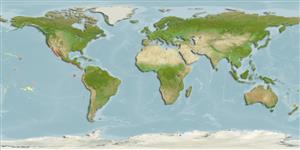>
Ophidiiformes (Cusk eels) >
Bythitidae (Livebearing brotulas)
Etymology: Grammonus: Greek, gramma = signal, mark + Greek, onos = hake.
Environment: milieu / climate zone / depth range / distribution range
Ecología
marino asociado a arrecife; rango de profundidad 6 - 18 m (Ref. 36488). Subtropical
Eastern Pacific: San Clemente Island in south California, USA to Panama and the Galapagos Islands.
Tamaño / Peso / Age
Maturity: Lm ? range ? - ? cm
Max length : 20.3 cm TL macho / no sexado; (Ref. 4930)
Espinas dorsales (total) : 0; Radios blandos dorsales (total) : 95 - 115; Espinas anales: 0; Radios blandos anales: 75 - 91; Vértebra: 60 - 63. Branchiostegal rays: 8 (Ref. 36488).
Uncommon species (Ref. 34024). Inhabits rocky areas of shallow waters (Ref. 2850). Hides in dark caverns and crevices during the day, active at night (Ref. 2850). Gives birth to live young (Ref. 28023).
Life cycle and mating behavior
Maturities | Reproducción | Spawnings | Egg(s) | Fecundities | Larva
Ovoviviparous (Ref. 36488).
Nielsen, J.G., D.M. Cohen, D.F. Markle and C.R. Robins, 1999. Ophidiiform fishes of the world (Order Ophidiiformes). An annotated and illustrated catalogue of pearlfishes, cusk-eels, brotulas and other ophidiiform fishes known to date. FAO Fish. Synop. 125(18):178p. Rome: FAO. (Ref. 34024)
IUCN Red List Status (Ref. 130435)
Threat to humans
Harmless
Human uses
Pesquerías: sin interés
Herramientas
Special reports
Download XML
Fuentes de Internet
Estimates based on models
Preferred temperature (Ref.
123201): 21.3 - 29.1, mean 26.7 °C (based on 204 cells).
Phylogenetic diversity index (Ref.
82804): PD
50 = 0.5005 [Uniqueness, from 0.5 = low to 2.0 = high].
Bayesian length-weight: a=0.00457 (0.00179 - 0.01169), b=3.10 (2.87 - 3.33), in cm total length, based on LWR estimates for this (Sub)family-body shape (Ref.
93245).
Nivel trófico (Ref.
69278): 3.5 ±0.50 se; based on food items.
Resiliencia (Ref.
120179): Alto, población duplicada en un tiempo mínimo inferior a 15 meses (Preliminary K or Fecundity.).
Fishing Vulnerability (Ref.
59153): Low vulnerability (10 of 100).
Nutrients (Ref.
124155): Calcium = 52.9 [24.3, 133.5] mg/100g; Iron = 0.662 [0.352, 1.248] mg/100g; Protein = 18 [15, 21] %; Omega3 = 0.163 [0.086, 0.306] g/100g; Selenium = 12 [5, 30] μg/100g; VitaminA = 67.1 [20.4, 228.7] μg/100g; Zinc = 0.994 [0.611, 1.562] mg/100g (wet weight);
